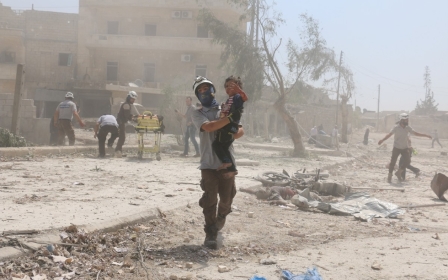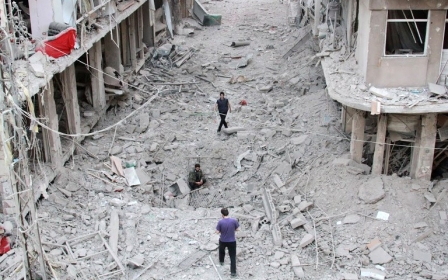More than a million people still under siege in Syria, says report
More than a million Syrians remain under siege even as the current US-Russia brokered ceasefire came into force, according to a damning report released by monitoring group Siege Watch on Tuesday.
The organisation, a joint project of the PAX peace organisation and the Syria Institute, said that more than a million people remain trapped in at least 40 besieged communities across the country as of July.
While Siege Watch acknowledged that thousands of people have since been brought out of the besieged Damascus district of Daraya, the report stressed that prior to this many civilians from rebel-held areas were often just transferred to other areas under siege, greatly limiting the overall drop in the number of Syrians trapped by fighting.
The group said that a further 1.4 million Syrians were on its watchlist as being under the threat of siege and Siege Watch urgently called on the international community to act.
"These mass evacuations contribute to what has become a clear policy of demographic engineering by the government of Syria."
"The situation for besieged Syrians appears grim. Six Siege Watch besieged communities were captured by force during the reporting period, displacing tens of thousands of people. Not a single siege was lifted through diplomatic means."
The evacuation of Daraya in August, following the surrender of rebels, was branded as "ethnic cleansing" by some opposition sources, pointing out the suburb is now virtually empty after the Syria government ended its siege. Syrian President Bashar al-Assad was shown by Syrian state TV defiantly praying in the city on Monday to mark the beginning of the Muslim festival of Eid al-Adha.
"The forcible evacuations raise a number of issues beyond the fact that people are often moved to other besieged areas: these mass evacuations contribute to what has become a clear policy of demographic engineering by the government of Syria," Valerie Szybala, the executive director of the Syria Institute, told Middle East Eye.
"Syria is already overwhelmed with a massive IDP [internally displaced person] crisis, and people displaced in this manner are very vulnerable to human rights violations such as enforced disappearances or military conscription."
The al-Waer district of Homs was singled out in the report as needing the most urgent attention from world powers with a community of almost 100,000 people on the verge of "complete collapse". It said: "The medical sector has been severely impacted by the intensified siege of al-Waer, with a lack of fuel and medical supplies hampering effective treatment for all conditions."
The report also warned that civilian deaths are mounting "due to lack of care for conditions like kidney disease", adding that the government of President Bashar al-Assad rarely allowed medical evacuations of the area.
The report went on to call on the UN and the International Syria Support Group (ISSG), a group of world powers working to find a solution to the crisis, to focus on ensuring free movement of civilians into and out of besieged areas, rather than concentrating on one-off aid convoys.
It also called on the bodies to "follow through on monitoring the implementation of any local ceasefire agreements that it helps to initiate".
Tense ceasefire
As part of the Russia-US brokered ceasefire, which began on Monday evening, aid convoys are set to roll into some of the worst hit areas. However, uncertainty over the stability of the truce has so far kept aid groups on the Turkey border, although agencies insist they are ready to deploy into Syria quickly.
Monday's ceasefire was greeted with wariness from the Syrian opposition, but its main umbrella group the Higher Negotiations Committee (HNC) appears to have accepted the ceasefire provided that certain "guarantees" about which groups would not be included were observed.
Russia said on Monday it would continue to target "terrorist" groups during a ceasefire in Syria, which includes the Fatah al-Sham formerly the al-Qaeda linked Nusra Front, as well as the Islamic State (IS) group.
The deal will be backed by "the largest groups", including Ahrar al-Sham, despite the latter voicing concerns over the viability of the deal and initially appearing to reject it.
As of Tuesday, the truce appeared to be holding, but analysts have warned that the ceasefire is likely to remain shaky while the international community is unable to punish violations.
"I believe [US] Secretary [of State John] Kerry noted at Friday's press conference that the deal requires 'unimpeded and sustained humanitarian access to all of the besieged and the hard-to-reach areas'. Priority for the besieged areas should be to focus on making this statement a reality," said Szybala.
"The most effective pressure that could be applied is for the terms of the agreement to actually be enforced, with consequences for violators. The lack of enforcement has been a fatal flaw in previous agreements as warring parties - particularly the Syrian government and its allies - have learned that they can commit violations with impunity."
This article is available in French on Middle East Eye French edition.
New MEE newsletter: Jerusalem Dispatch
Sign up to get the latest insights and analysis on Israel-Palestine, alongside Turkey Unpacked and other MEE newsletters
Middle East Eye delivers independent and unrivalled coverage and analysis of the Middle East, North Africa and beyond. To learn more about republishing this content and the associated fees, please fill out this form. More about MEE can be found here.





